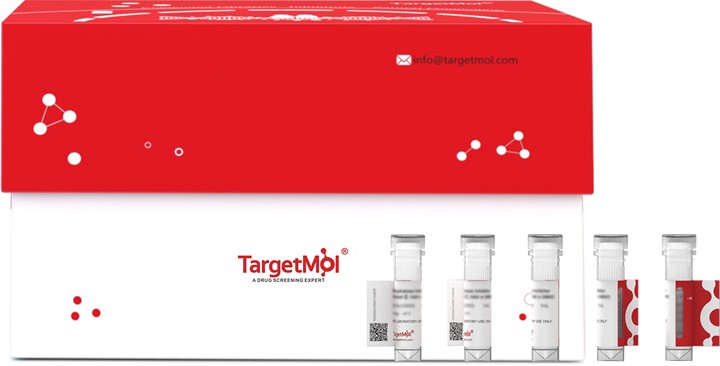Shopping Cart
Remove All Your shopping cart is currently empty
Your shopping cart is currently empty
OSMR is targeted to the mitochondrial matrix via the presequence translocase-associated motor complex components, mtHSP70 and TIM44. OSMR interacts with NADH ubiquinone oxidoreductase 1/2 (NDUFS1/2) of complex I and promotes mitochondrial respiration. Deletion of OSMR impairs spare respiratory capacity, increases reactive oxygen species, and sensitizes BTSCs to IR-induced cell death. OSMR Protein, Canine, Recombinant (His) is expressed in HEK293 mammalian cells with C-His tag. The predicted molecular weight is 81.73 kDa and the accession number is A0A8I3MI11.

| Pack Size | Price | USA Warehouse | Global Warehouse | Quantity |
|---|---|---|---|---|
| 5 μg | $58 | 7-10 days | 7-10 days | |
| 10 μg | $92 | 7-10 days | 7-10 days | |
| 20 μg | $148 | 7-10 days | 7-10 days | |
| 50 μg | $289 | 7-10 days | 7-10 days | |
| 100 μg | $487 | 7-10 days | 7-10 days | |
| 200 μg | $883 | 7-10 days | 7-10 days | |
| 500 μg | $1,950 | 7-10 days | 7-10 days |
| Biological Activity | Activity has not been tested. It is theoretically active, but we cannot guarantee it. If you require protein activity, we recommend choosing the eukaryotic expression version first. |
| Description | OSMR is targeted to the mitochondrial matrix via the presequence translocase-associated motor complex components, mtHSP70 and TIM44. OSMR interacts with NADH ubiquinone oxidoreductase 1/2 (NDUFS1/2) of complex I and promotes mitochondrial respiration. Deletion of OSMR impairs spare respiratory capacity, increases reactive oxygen species, and sensitizes BTSCs to IR-induced cell death. OSMR Protein, Canine, Recombinant (His) is expressed in HEK293 mammalian cells with C-His tag. The predicted molecular weight is 81.73 kDa and the accession number is A0A8I3MI11. |
| Species | Canine |
| Expression System | HEK293 Cells |
| Tag | C-His |
| Accession Number | A0A8I3MI11 |
| Synonyms | PLCA1,OSMRBMGC150626,OSMRB,OSMR β,OSMR beta,OSMR,IL-31R-β,IL-31R-beta,IL-31RB,IL-31R subunit β,IL-31R subunit beta |
| Construction | Glu28-Pro735 |
| Protein Purity | > 95% as determined by Tris-Bis PAGE; > 95% as determined by HPLC |
| Molecular Weight | 81.73 kDa (predicted). Due to glycosylation, the protein migrates to 110-130 kDa based on Tris-Bis PAGE result. |
| Endotoxin | < 1 EU/μg by the LAL method. |
| Formulation | Lyophilized from a solution filtered through a 0.22 μm filter, containing PBS (pH 7.4). Typically, 8% trehalose is incorporated as a protective agent before lyophilization. |
| Reconstitution | Reconstitute the lyophilized protein in distilled water. The product concentration should not be less than 100 μg/ml. Before opening, centrifuge the tube to collect powder at the bottom. After adding the reconstitution buffer, avoid vortexing or pipetting for mixing. |
| Stability & Storage | It is recommended to store recombinant proteins at -20°C to -80°C for future use. Lyophilized powders can be stably stored for over 12 months, while liquid products can be stored for 6-12 months at -80°C. For reconstituted protein solutions, the solution can be stored at -20°C to -80°C for at least 3 months. Please avoid multiple freeze-thaw cycles and store products in aliquots. |
| Shipping | In general, Lyophilized powders are shipping with blue ice. |
| Research Background | OSMR is targeted to the mitochondrial matrix via the presequence translocase-associated motor complex components, mtHSP70 and TIM44. OSMR interacts with NADH ubiquinone oxidoreductase 1/2 (NDUFS1/2) of complex I and promotes mitochondrial respiration. Deletion of OSMR impairs spare respiratory capacity, increases reactive oxygen species, and sensitizes BTSCs to IR-induced cell death. |
| Size | Quantity | Unit Price | Amount | Operation |
|---|

Copyright © 2015-2025 TargetMol Chemicals Inc. All Rights Reserved.